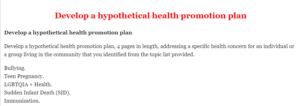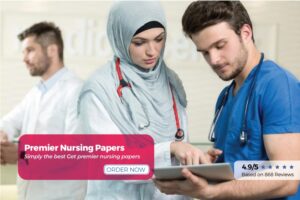Develop a hypothetical health promotion plan
Develop a hypothetical health promotion plan
Develop a hypothetical health promotion plan
Develop a hypothetical health promotion plan, 4 pages in length, addressing a specific health concern for an individual or a group living in the community that you identified from the topic list provided.
Bullying.
Teen Pregnancy.
LGBTQIA + Health.
Sudden Infant Death (SID).
Immunization.
Tobacco use (include all: vaping, e-cigarettes, hookah, chewing tobacco, and smoking) cessation.
As an advocate and educator, the community/public health nurse is instrumental in providing individuals, groups, and aggregates with the tools that are essential for health promotion and disease prevention. There is a connection between one’s quality of life and their health literacy. Health literacy is related to the knowledge, comprehension, and understanding of one’s condition along with the ability to find resources that will treat, prevent, maintain, or cure their condition. Health literacy is impacted by the individual’s learning style, reading level, and the ability understand and retain the information being provided. The individual’s technology aptitude and proficiency in navigating available resources is an essential component to making informed decisions and to the teaching learning process (CDC, 2012; Healthy People 2030, n.d.).
It is essential to develop trust and rapport with community members to accurately identify health needs and help them adopt health promotion, health maintenance, and disease prevention strategies. Cultural, socio-economical, and educational biases need to be taken into consideration when communicating and developing an individualized treatment and educational plan. Social, economic, cultural, and lifestyle behaviors can have an impact on an individual’s health and the health of a community. These behaviors may pose health risks, which may be mitigated through lifestyle/behaviorally-based education. The environment, housing conditions, employment factors, diet, cultural beliefs, and family/support system structure play a role in a person’s levels of risk and resulting health. Assessment, evaluation, and inclusion of these factors provide a basis for the development of an individualized plan. The health professional may use a genogram or sociogram in this process.
What is a genogram? A genogram, similar to a family tree, is used to gather detailed information about the quality of relationships and interactions between family members over generations as opposed to lineage. Gender, family relationships, emotional relationships, lifespan, and genetic predisposition to certain health conditions are components of a genogram. A genogram, for instance, may identify a pattern of martial issues perhaps rooted in anger or explain why a person has green eyes.
What is a sociogram? A sociogram helps the health professional to develop a greater understanding of these factors by seeing inter-relationships, social links between people or other entities, as well as patterns to identify vulnerable populations and the flow of information within the community.
References
Centers for Disease Control and Prevention. (2012). Lesson 1: Introduction to epidemiology. In Principles of Epidemiology in Public Health Practice (3rd ed.). https://www.cdc.gov/csels/dsepd/ss1978/lesson1/section1.html
U.S. Department of Health and Human Services, Office of Disease Prevention and Health Promotion. (n.d.). Healthy People 2030. https://health.gov/healthypeople
Demonstration of Proficiency
Must do: please make sure the essay has covered these 3 points. Thank you!
IMPORTANT!!!!!
Competency 1: Analyze health risks and health care needs among distinct populations.
Analyze a community health concern that is the focus of a health promotion plan.
Competency 2: Propose health promotion strategies to improve the health of populations.
Explain why a health concern is important for health promotion within a specific population.
Establish agreed-upon health goals in collaboration with participants.
Competency 5: Apply professional, scholarly communication strategies to lead health promotion and improve population health.
Organize content so ideas flow logically with smooth transitions; contains few errors in grammar/punctuation, word choice, and spelling.
Apply APA formatting to in-text citations and references exhibiting nearly flawless adherence to APA format
References to use:
Abrampah, N. M., Syed, S. B., Hirschhorn, L. R., Nambiar, B., Iqbal, U., Garcia-Elorrio, E. Chattu, V. K., Devnani, M., & Kelley, E. (2018). Quality improvement and emerging global health priorities. International Journal for Quality in Health Care, 30(Suppl 1), 5-9. https://academic.oup.com/intqhc/article/30/suppl_1/5/4980402
Centers for Disease Control and Prevention. (n.d.). Clinician Outreach and Communication Activity (COCA). https://emergency.cdc.gov/coca/index.asp
Centers for Disease Control and Prevention. (n.d.). Global health. https://www.cdc.gov/globalhealth/index.html
Edmonson, C., McCarthy, C., Trent-Adams, S., McCain, C., & Marshall, J. (2017). Emerging global health issues: A nurse’s role. Online Journal of Issues in Nursing, 22(1), 1-13. No
Culturally diverse communities.
Murdaugh, C. L., Parsons, M. A., & Pender, N. J. (2018). Health promotion in nursing practice (8th ed.). Pearson. Available in the courseroom via the VitalSource Bookshelf link.
Part 3: Interventions for Health Promotion and Prevention.
Flanders, S. A. (2018). Effective patient education: Evidence and common sense. Medsurg Nursing, 27(1), 55–58.
Loan, L. A., Parnell, T. A., Stichler, J. F., Boyle, D. K., Allen, P., VanFosson, C. A., & Barton, A. J. (2018). Call for action: Nurses must play a critical role to enhance health literacy. Nursing Outlook, 66(1), 97–100.
Ritchie, U. C., Turner, S. C., & Field, C. (2017). Development and utility of a medication self-assessment tool for community-based healthcare services. Journal of Pharmacy Practice & Research, 47(2), 140–146.
Sanford, K. (Ed.). (2018). Advocacy for all—but especially for the most vulnerable. Nursing Administration Quarterly, 42(2), 100–106.
Minogue, T. D., Koehler, J. W., Stefan, C. P., & Conrad, T. A. (2019). Next-generation sequencing for biodefense: Biothreat detection, forensics, and the clinic. Clinical Chemistry, 65(3), 383–392.
World Health Organization. (n.d.). Health promoting schools.https://www.who.int/health-topics/health-promoting-schools
Answer preview  APA
APA
1242 words
Use the following coupon code :
premiernursingpapers


